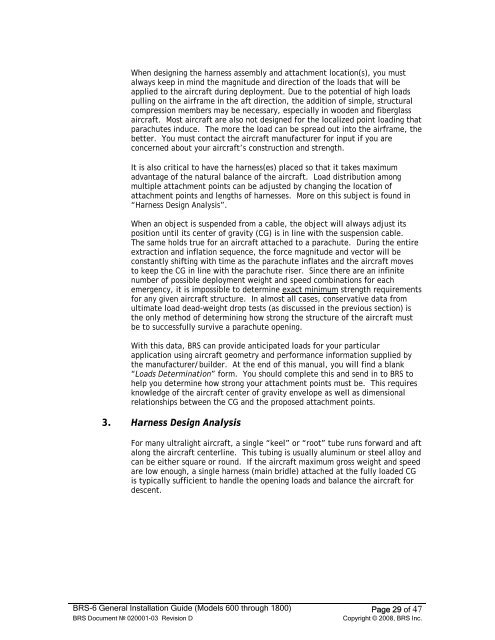BRS-6 General Installation Guide - CAFE Foundation
BRS-6 General Installation Guide - CAFE Foundation
BRS-6 General Installation Guide - CAFE Foundation
You also want an ePaper? Increase the reach of your titles
YUMPU automatically turns print PDFs into web optimized ePapers that Google loves.
When designing the harness assembly and attachment location(s), you must<br />
always keep in mind the magnitude and direction of the loads that will be<br />
applied to the aircraft during deployment. Due to the potential of high loads<br />
pulling on the airframe in the aft direction, the addition of simple, structural<br />
compression members may be necessary, especially in wooden and fiberglass<br />
aircraft. Most aircraft are also not designed for the localized point loading that<br />
parachutes induce. The more the load can be spread out into the airframe, the<br />
better. You must contact the aircraft manufacturer for input if you are<br />
concerned about your aircraft’s construction and strength.<br />
It is also critical to have the harness(es) placed so that it takes maximum<br />
advantage of the natural balance of the aircraft. Load distribution among<br />
multiple attachment points can be adjusted by changing the location of<br />
attachment points and lengths of harnesses. More on this subject is found in<br />
“Harness Design Analysis”.<br />
When an object is suspended from a cable, the object will always adjust its<br />
position until its center of gravity (CG) is in line with the suspension cable.<br />
The same holds true for an aircraft attached to a parachute. During the entire<br />
extraction and inflation sequence, the force magnitude and vector will be<br />
constantly shifting with time as the parachute inflates and the aircraft moves<br />
to keep the CG in line with the parachute riser. Since there are an infinite<br />
number of possible deployment weight and speed combinations for each<br />
emergency, it is impossible to determine exact minimum strength requirements<br />
for any given aircraft structure. In almost all cases, conservative data from<br />
ultimate load dead-weight drop tests (as discussed in the previous section) is<br />
the only method of determining how strong the structure of the aircraft must<br />
be to successfully survive a parachute opening.<br />
With this data, <strong>BRS</strong> can provide anticipated loads for your particular<br />
application using aircraft geometry and performance information supplied by<br />
the manufacturer/builder. At the end of this manual, you will find a blank<br />
“Loads Determination” form. You should complete this and send in to <strong>BRS</strong> to<br />
help you determine how strong your attachment points must be. This requires<br />
knowledge of the aircraft center of gravity envelope as well as dimensional<br />
relationships between the CG and the proposed attachment points.<br />
3. Harness Design Analysis<br />
For many ultralight aircraft, a single “keel” or “root” tube runs forward and aft<br />
along the aircraft centerline. This tubing is usually aluminum or steel alloy and<br />
can be either square or round. If the aircraft maximum gross weight and speed<br />
are low enough, a single harness (main bridle) attached at the fully loaded CG<br />
is typically sufficient to handle the opening loads and balance the aircraft for<br />
descent.<br />
<strong>BRS</strong>-6 <strong>General</strong> <strong>Installation</strong> <strong>Guide</strong> (Models 600 through 1800) Page 29 of 47<br />
<strong>BRS</strong> Document № 020001-03 Revision D Copyright © 2008, <strong>BRS</strong> Inc.

















